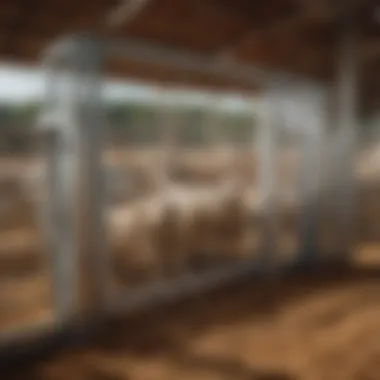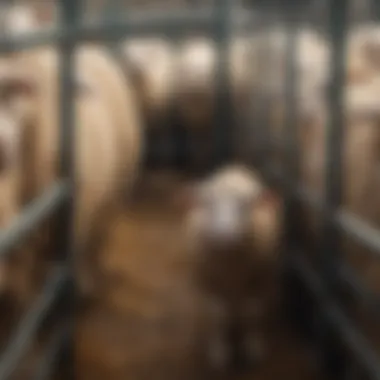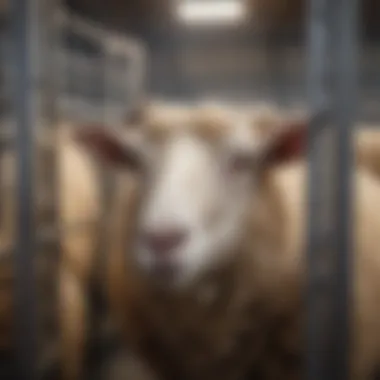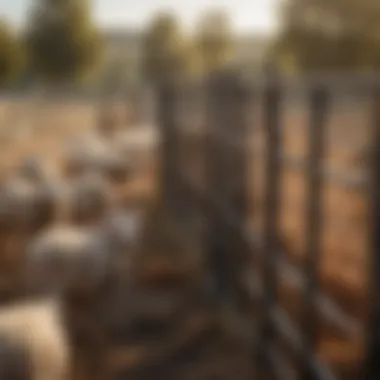Understanding Sheep Sorting Gates in Agriculture


Intro
Sheep sorting gates are essential tools in modern livestock management. Their design caters specifically to the needs of farmers who handle large volumes of sheep. Understanding these gates helps in optimizing operations, reducing labor costs, and increasing overall farm efficiency.
Efficient sorting, particularly during breeding, health checks, and feeding, is critical for a successful livestock operation. With detailed insights into the functionality and benefits of sheep sorting gates, farmers can make informed decisions that improve their practices.
Topic Overview
Definition and Importance
A sheep sorting gate is a mechanism used to separate sheep based on specified criteria such as age, weight, or health status. These gates aid in creating a streamlined process for managing flocks, providing a humane and effective way to handle sheep during various farming activities. The importance of these gates cannot be overstated, as they contribute to better herd health management and operational efficacy.
Brief History and Evolution
The history of sheep sorting gates traces back to traditional manual sorting methods, which were labor-intensive and time-consuming. As agricultural practices evolved, so did the technology behind sorting systems. Today, advanced sheep sorting gates incorporate features like electronic identification systems, which further enhance the sorting process.
With innovations, these gates have become easier to operate and more reliable in their function. Much like the broader evolution of agricultural tools, sheep sorting gates show a trend towards increasing efficiency and sustainability.
Key Techniques and Innovations
Sustainable Farming Practices
Sustainable farming practices can benefit significantly from the implementation of sheep sorting gates. They reduce the time spent on sorting, allowing farmers to allocate resources more effectively. Proper utilization of these gates promotes animal welfare, as sheep experiences less stress during handling.
Advanced Agronomic Technologies
Technological advances have led to the development of automated sheep sorting gates, which can use RFID technology to track and manage sheep. This innovation allows for a more accurate sorting process and helps maintain detailed records on each animal.
Practical Applications
Step-by-Step Guides
To implement sheep sorting gates effectively, farmers should consider the following steps:
- Assessment of Needs: Determine the specific needs of the flock and how sorting can improve management.
- Selection of Equipment: Choose a sorting gate that aligns with operational goals. Evaluate features like capacity, automation, and maintenance requirements.
- Installation: Properly install the gate ensuring safety and functionality.
- Training: Train staff on how to use sorting gates to maximize efficiency and manage sheep effectively.
Case Studies or Real-World Examples
Farmers have successfully integrated sheep sorting gates in many operations. For instance, a case study from a farm in New Zealand highlighted a 30% reduction in time spent on sorting due to the installation of an automated sorting gate. This allowed the farmer to reallocate time to other critical tasks like pasture management.
"The implementation of sheep sorting gates revolutionized our operation. We could manage our flock with greater ease and efficiency, significantly reducing labor costs."
— New Zealand Farmer
Intro to Sheep Sorting Gates
Sheep sorting gates serve an essential function in the realm of livestock management. These gates offer farmers a strategic means to efficiently manage and sort their sheep. Their significance lies not only in improving operational efficiency but also in ensuring the welfare of the livestock.
Definition and Purpose
Sheep sorting gates are specialized barriers designed to manage the flow and movement of sheep within a farm setting. They enable farmers to separate animals based on various criteria such as age, health status, or breeding readiness. The primary purpose of these gates is to facilitate easier handling during veterinary checks or shearing processes, as well as during the organization of breeding stock. By incorporating these gates into their operations, farmers can save time, reduce labor costs, and ultimately enhance the overall productivity of their livestock management.
Historical Context
The evolution of sheep sorting gates can be traced back to traditional farming practices where manual sorting was commonplace. Initially, farmers relied on simple physical barriers to separate sheep, which were labor-intensive and often stressful for the animals. Over the years, advancements in agriculture and technology have led to the development of more sophisticated sorting mechanisms. Today, various designs and materials are available to suit a farmer's unique requirements. The modern sheep sorting gate is a product of this evolution, combining functionality with ease of use. Its design is often informed by both historical practices and contemporary innovations, making it a pivotal tool in today's agricultural landscape.
"Efficiency in sheep management hinges on the thoughtful integration of practical tools, like sorting gates, into the daily operations of the farm."
In summary, sheep sorting gates not only play a crucial role in streamlining farming practices but also reflect the evolving needs of the agricultural industry. Their significance cannot be understated, as they contribute toward improved livestock handling and overall farm efficiency.


Design Aspects of Sheep Sorting Gates
The design of sheep sorting gates plays a crucial role in the overall functionality and effectiveness of livestock management systems. These gates must not only facilitate ease of movement for sheep but also ensure that the sorting process is efficient and minimizes stress for the animals. As farms modernize, understanding the design elements becomes essential for farmers who aim to maintain high standards of animal welfare while also improving productivity.
Material Selection
Choosing the right materials for sheep sorting gates is essential to ensure durability, safety, and functionality. Common materials include galvanized steel, aluminum, and plastic composites. Each has its own benefits:
- Galvanized Steel: Known for its strength, this material can withstand various weather conditions, making it suitable for outdoor usage.
- Aluminum: Lightweight and resistant to corrosion, aluminum gates are easier to handle but may not be as robust as their steel counterparts.
- Plastic Composites: These are often used for their flexibility in design and are resistant to rust, making them an attractive option where maintenance is a concern.
In selecting materials, farmers should also consider the cost-effectiveness and the lifespan of the gates. A well-chosen material will contribute to long-term savings and operational efficiency.
Mechanisms and Operation
The mechanisms installed within sheep sorting gates are integral to their operation. Various designs can dictate the ease with which gates open and close, thereby impacting the sorting process. Common mechanisms include:
- Manual Lever Systems: Simple but effective, these systems allow the operator to control the gates with minimal effort.
- Electric Operated Gates: These gates can be controlled remotely, which can drastically reduce the time taken to sort animals. They are beneficial in larger operations where speed is of the essence.
- Sensor-Activated Gates: Advanced options include gates that open automatically when animals approach, greatly enhancing sorting efficiency.
Understanding the operational mechanics is vital for making an informed choice that aligns with the farm's workflow demands.
Customization Options
Customization options for sheep sorting gates allow farmers to tailor solutions to their specific needs and the unique layout of their facilities. Several aspects can be customized:
- Gate Size: The size can be adjusted to accommodate different breeds of sheep or to fit within existing infrastructure.
- Adjustable Panels: These allow gates to adapt to varying sheep sizes or types, enhancing the sorting process.
- Safety Features: Adding features such as safety locks, rounded edges, and anti-escape designs can improve both animal safety and operator peace of mind.
Customization not only improves the functionality of sheep sorting gates but also can contribute to a more organized and effective livestock management strategy. Farmers should assess their unique conditions to make effective choices.
Functional Benefits of Sheep Sorting Gates
Sheep sorting gates are essential tools in modern livestock management. They offer several functional advantages that impact both the operational efficiency of sheep farming and the welfare of the animals involved. By streamlining the sorting processes, these gates contribute to better management practices, which are crucial for maximizing productivity while ensuring the well-being of livestock.
Enhanced Efficiency
One of the most significant advantages of sheep sorting gates is their ability to enhance operational efficiency. Sorting sheep can be time-consuming and labor-intensive without proper equipment. With automatic or semi-automatic sorting gates, farmers can significantly reduce the time needed to move and separate sheep for various purposes, such as health monitoring, shearing, or breeding.
- Time Savings: Automated systems allow farmers to sort larger groups of sheep in a shorter time. This reduction in manual labor saves valuable time and resources.
- Labor Allocation: With the efficiency brought by sorting gates, farmers can allocate their workforce to other essential tasks rather than spending extended periods on sorting.
- Overall Productivity: Enhanced efficiency often translates to higher productivity levels. Farmers can manage more sheep or raise a more significant number of lambs without overwhelming their resources.
Minimized Stress on Livestock
Stress management is crucial in livestock farming. Sheep are sensitive animals, and handling them improperly can lead to negative health outcomes. By using sorting gates, the stress on animals during the sorting process can be minimized.
- Gentle Handling: Sorting gates often feature designs that prioritize the comfort and safety of the sheep. This means fewer injuries and better overall health.
- Calm Environment: Automatic systems reduce the noise and confusion that often accompany manual sorting. A calmer environment helps prevent panic and keeps the sheep settled.
- Improved Health: Stress can lead to a range of health issues in sheep. Therefore, reducing stress during handling can lead to better overall herd health and lower veterinary costs over time.
Improved Sorting Accuracy
Accuracy in sorting sheep is essential, especially when it comes to breeding, health management, or selling livestock. Sheep sorting gates enhance sorting precision, minimizing the risk of errors in animal management.
- Targeted Sorting: Advanced systems can be programmed to sort sheep based on various criteria, such as age, weight, or health status. This targeted approach ensures that each sheep is categorized correctly.
- Data-Driven Decisions: Some modern sheep sorting gates come equipped with data collection capabilities, allowing farmers to keep track of individual animal performance metrics. This data-driven approach leads to better-informed management decisions.
- Reduced Mix-Ups: The design of sorting gates can effectively prevent unwanted mixing of different flocks or groups, maintaining the integrity of management practices.
The benefits of sheep sorting gates cannot be understated. They transform how farmers manage their livestock by enhancing efficiency, reducing stress, and improving accuracy in sorting processes.
Technological Integration in Sheep Sorting Gates
Technological integration is a pivotal aspect of modern sheep sorting gates. This integration enhances the overall management of livestock by incorporating advanced features that streamline operations. The introduction of automation and data collection not only improves efficiency but also elevates the level of precision in sheep handling.
Automation Features
Automation in sheep sorting gates refers to the utilization of technology to carry out tasks without human intervention. This can range from simple mechanical systems to sophisticated software solutions. Automated systems are designed to handle sorting tasks rapidly and efficiently, often increasing throughput with minimal human labor.


Key benefits of automation include:
Reduced labor costs: Fewer personnel are needed on-site, which lowers overhead.
- Increased accuracy: Automated systems often provide more exact sorting capabilities.
- Time-saving: Processes that might take hours can be completed in minutes.
Automated gates can be programmed to respond to specific criteria, such as weight, breed, or health status. This means farmers can sort sheep based on a variety of factors using sensors and software systems, leading to more effective decision-making in herd management.
Data Collection Capabilities
The ability to collect data in real-time during sheep sorting is another crucial advancement. Modern systems come equipped with sensors that not only detect individual animals but also record essential data. This data can include weight, age, health metrics, and more, providing valuable insights for farmers.
Such capabilities allow for better tracking of livestock performance and health. For example, farmers can:
- Monitor growth rates over time
- Identify health issues early
- Make informed breeding decisions
Moreover, data collected from sorting gates can be integrated with farm management software. This integration offers a comprehensive overview of operations, allowing for enhanced planning and productivity. Farmers can analyze trends and make adjustments to improve overall farm efficiency.
"The fusion of automation and data collection reflects a significant shift in livestock management, allowing for smarter and more efficient practices."
Best Practices for Operating Sorting Gates
Effective operation of sheep sorting gates is crucial in modern agriculture. Proper management of these systems not only streamlines the sorting process but also enhances the overall welfare of the livestock. Understanding the nuances of best practices can significantly improve the functioning and efficiency of sorting gates.
Training Staff Effectively
Training staff to operate sorting gates is a key element in harnessing their full potential. Knowledgeable workers can make quick decisions based on the behavior and needs of the sheep. Effective training covers several aspects:
- Understanding Gate Mechanics: Employees should be familiar with how the gate works, including its controls and emergency overrides.
- Animal Behavior: Staff must learn to interpret sheep behavior. Recognizing signs of stress or discomfort helps minimize issues during sorting.
- Safety Protocols: A clear focus on safety can protect both the staff and the sheep. Training should include techniques for handling sheep gently and ensuring personal safety.
Ultimately, well-trained staff lead to smoother operations and less anxiety for the animals, which translates into better productivity.
Maintenance and Care
Regular maintenance of sorting gates is essential to ensure their longevity and functionality. Maintenance involves:
- Routine Inspections: Regular checks on hinges, motors, and sensors can help identify potential issues before they become problematic.
- Cleaning: Debris or build-up can affect the operation of the gates. Keeping the machinery clean prevents malfunctions and operational delays.
- Lubrication: Moving parts need to be lubricated to ensure smooth operation. Neglecting this can lead to wear and tear, increasing repair costs.
In summary, consistent maintenance and proper care can enhance the performance of sorting gates and prevent unexpected breakdowns, best serving both the farmer's interests and animal welfare.
Proper operation and care of sheep sorting gates lead to efficient livestock management and improved productivity.
Using these best practices, farmers can optimize the operation of sheep sorting gates, thus benefiting their livestock management efforts.
Challenges in Implementing Sheep Sorting Gates
The implementation of sheep sorting gates poses several challenges for farmers and agriculturalists. Understanding these challenges is crucial for successful installation and utilization. Addressing the associated difficulties can lead to better operational efficiencies and enhance livestock management practices.
Cost Concerns
Cost is often the first barrier that farmers face when considering sheep sorting gates. The initial investment may seem significant, especially for smaller operations. These gates can range widely in price. Factors influencing the cost include the material used and technological features. For instance, gates equipped with advanced automation or data collection capabilities increase overall expenses.
Additionally, ongoing costs must be factored in, like maintenance, repairs, and possible upgrades. Farmers need to carefully analyze the return on investment. A breakdown of long-term savings due to increased efficiency can be beneficial. Saving time during animal sorting can offset initial costs.
A detailed financial plan evaluating this equipment is essential before proceeding with purchase or installations. Farmers can also seek consultation for financing options that would allow them to spread costs over time.
User-Friendliness Issues


Another challenge in implementing sheep sorting gates revolves around user-friendliness. Even the best-designed gate can struggle if it is not intuitive for staff. New technology can sometimes create confusion. Staff must be trained properly on operations. Without adequate training, the potential efficiency gains may not be realized.
Design complexity can also deter effective use. While features like remote operation may seem beneficial, they can complicate functionality for users unfamiliar with the technology.
Moreover, the placement of gates within existing setups can impact their ease of use. A poorly positioned gate can disrupt workflow, causing frustration among workers and reducing operational effectiveness. Therefore, ensuring that the design is clear and accessible for all users is vital. Simplicity in operation encourages user engagement and maximizes productivity.
"Investing in training and considering user experience during installation can alleviate some of the common issues encountered in sheep sorting gate operations."
Addressing cost concerns and user-friendliness issues can help integrate sheep sorting gates into farming operations more smoothly. By prioritizing these aspects, farmers can enhance their productivity and streamline their livestock management.
Case Studies and Practical Applications
In the context of modern agriculture, sheep sorting gates play a pivotal role. They not only streamline the management of sheep but also enhance productivity through precise sorting and handling. Understanding the real-world implications of these gates offers farmers critical insights into their applications. Case studies highlight successful implementations and shed light on the practical benefits that can be derived from efficient sheep management systems.
Successful Implementations
Numerous farms have integrated sheep sorting gates into their operations, leading to improved workflow. For instance, one notable case is a farm in New Zealand that adopted the Gallagher Smart Gate. The gate is designed to allow farmers to sort sheep based on various criteria like weight and health status. Implementation of this technology has shown a 20% increase in sorting efficiency. Farmers noted that the reduced time spent handling sheep allocated more time for other farm activities.
Another case involves a ranch in Australia that utilized the Tru-Test EID (Electronic ID) Gate System. This system can automatically identify sheep when they pass through. The results were promising. The ranch reported less handling stress on livestock and significant labor savings. These examples reflect the growing trend of integrating technology in sheep sorting, showcasing its effectiveness in enhancing operational capability.
Lessons Learned from Users
Analyzing the experiences of users reveals important lessons regarding sheep sorting gates. A common theme emerged about the necessity of training staff properly to maximize the technology's benefits. For instance, a farmer in the UK noted that initial difficulties with the new system led to frustration. However, after a series of training sessions, staff became more competent. As a result, their sorting accuracy significantly improved.
Moreover, feedback from users highlighted the importance of regular maintenance. A case in the United States stressed that neglecting care led to mechanical issues. Regularly scheduled checks ensured longevity and optimal performance of the gates. Users learned that investing time in maintenance is critical in preserving efficiency.
Effective implementation of sheep sorting gates requires not only the right technology but also adequate training and maintenance practices.
In summary, case studies illustrate that adopting sheep sorting gates can lead to tangible benefits in efficiency and productivity. Learning from user experiences enhances understanding of best practices, emphasizing training and maintenance as crucial components for success.
Future Trends in Sheep Handling Technology
As agriculture evolves, the demand for more efficient livestock management practices grows. The future of sheep handling technology is pivotal for enhancing farm operations and aligns with emerging needs for reliability and sustainability. By harnessing new innovations, farmers can optimize the management of their sheep, which assists not only in productivity but also in the welfare of the animals.
Innovations on the Horizon
Several technologies are surfacing that promise to significantly influence sheep handling practices. One notable advancement is the rise of smart sorting gates equipped with artificial intelligence. These systems can learn animal behaviors, allowing them to make more informed sorting decisions based on each sheep's characteristics. Such precision enhances efficiency, as farmers can better group their livestock for feeding, breeding, or medical interventions.
Another exciting area is the integration of biometric technology. Systems that utilize RFID tags or other biometric identification allow for seamless tracking of each livestock's health status and movement. This ensures farmers have real-time insights, which can improve overall herd management. As these systems grow smarter, they will likely become invaluable tools in everyday operations.
Sustainability Considerations
Sustainability plays a crucial role in the future of sheep handling technology. Farmers face increasing pressures to minimize the environmental impacts of their operations. Innovations in sorting gates are focusing on sustainable materials and designs that reduce waste and enhance energy efficiency.
Moreover, future trends include solar-powered gates that not only lower electricity costs but also reduce reliance on fossil fuels. Incorporating renewable energy sources supports a more eco-friendly approach to livestock management.
In addition, by improving sorting and handling processes, sheep sorting gates contribute to reducing animal stress and improving health outcomes. This is not only ethical but also enhances productivity, aligning with the broader trend toward sustainable agriculture practices. Farmers can expect that future solutions will continue to balance operational efficiency with environmental stewardship, ultimately supporting a healthier planet.
"Innovative technologies in sheep handling do not just improve processes; they redefine the relationship between farmers and their livestock."
In summary, the trends in sheep handling technology indicate a shift toward smarter, more sustainable practices aimed at improving both productivity and animal welfare. As these technologies develop, they promise to bring tangible benefits to the agricultural field.
Ending: The Role of Sheep Sorting Gates in Modern Agriculture
In the context of this article, sheep sorting gates represent a pivotal advancement in livestock management. These gates are not merely physical structures; they embody a comprehensive solution to improve the efficiency of operations on sheep farms. Their implementation reflects a thoughtful amalgamation of design, technology, and agricultural practices aimed at optimizing animal management.
One critical aspect is the efficiency they introduce. By streamlining the process of sorting sheep, these gates allow farmers to save time and resources. Sorting sheep manually can be labor-intensive and prone to errors. With sheep sorting gates, automation can greatly reduce the workload, leading to more organized herding and handling of livestock.
Another significant element is animal welfare. Stress can have detrimental effects on sheep health and productivity. Efficient sorting minimizes the anxiety experienced by livestock during handling. This results in a calmer environment for sheep, which in turn can lead to better health outcomes and improved wool and meat quality.
Additionally, the data collection capabilities integrated into modern sheep sorting gates cannot be overlooked. These features empower farmers to track performance metrics and manage flock health effectively. By analyzing the collected data, farmers can make informed decisions about breeding, nutrition, and overall herd management. This analytical approach not only enhances individual farm productivity but also contributes to better industry standards.
Moreover, customization options in the design of these gates cater to the specific needs of different farms. Each operation is unique, and having the ability to adapt sorting gates accordingly allows for a more personalized approach to livestock handling. This customization fosters greater satisfaction among farmers and ultimately influences the success of their farming practices.
In summary, the role of sheep sorting gates in modern agriculture extends beyond simple functionality. Their multifaceted benefits—ranging from increased operational efficiency to improved animal welfare—demonstrate their importance as a transformative tool in livestock management. As technology continues to evolve, so too will these systems, ensuring they remain relevant and beneficial in the future landscape of agricultural practices.



